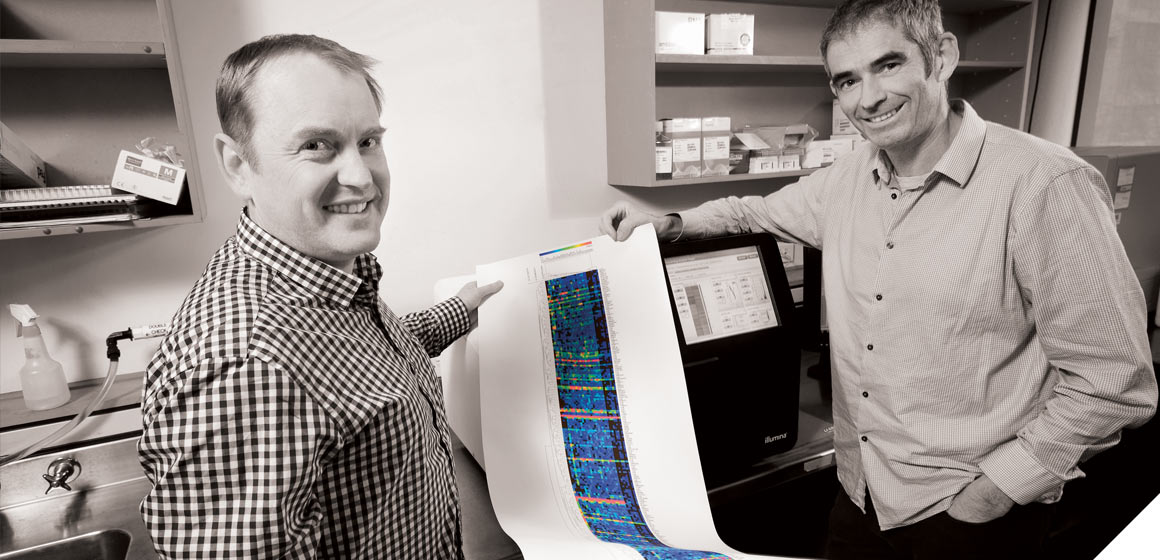 Monday 3 February 2014 11:19am
Monday 3 February 2014 11:19amThe more we learn about cancer, the more complex it appears to be – but now new techniques offer hope for more effective diagnosis and treatment.
Professor Parry Guilford and Dr Rob Day, of the Department of Biochemistry's Cancer Genetics Laboratory, are using genomic sequencing to try to develop less invasive and more accurate and informative tests for the disease.
Guilford and Day, investigators at the University's Centre for Translational Cancer Research (CTCR), are working on analysing the genomes of single cells taken from biological fluids to improve the sensitivity of cancer detection and gather information that may be used to better select treatment for any diagnosed cancer.
"We're always trying to find ways to prevent cancer or to stop its advance or treat cancer that has got away," says Guilford.
"These are very much early days, but we're getting much better at targeting cancer therapies, so there's quite a bright future for drugs to treat individual cancers."
The work has recently attracted support from the Ministry of Business, Innovation and Employment's Smart Ideas fund, which looks for novel, high quality research that is likely to deliver results.
It's a good fit for CTCR, which embraces studies that aim to improve cancer treatment in a relatively short timeframe, typically less than five years.
"We can still do basic research, but we are more focused on getting to a clinical end point, keeping the mindset that we need to help improve outcomes. We look for answers to quite pragmatic questions, and take existing knowledge and apply it to problems."
"By separating out single cells and sequencing them, we can identify rare cancer cells more easily and obtain information that will also likely inform future treatment options."
Through CTCR, Otago researchers in cancer genetics and immunology join with leading oncologists and surgeons to bridge the gap between laboratory-based science and clinical applications.
Because of the short timeframe demanded, research usually involves clinical studies and direct analysis of human tissue samples such as tumour biopsies and biological fluids.
Guilford and Day's work on single-cell genomic sequencing is likely to improve detection, leading to earlier, better treatment.
Current diagnostics have limitations. "If you want to try to diagnose bladder cancer, for example, you take a urine sample. But there are many different cells in that sample and the signals from a small tumour could easily be swamped by those from other cells," says Guilford.
"By separating out single cells and sequencing them, we can identify rare cancer cells more easily and obtain information that will also likely inform future treatment options."
With a growing body of knowledge of cancer biology, molecular biology and immunology, targeted treatment is likely to be more effective.
"There are still technical problems to solve, but that's where we are heading. The information is there in principle and we would hope our methods will be in use within five years."
A pilot study is focusing on applying the technology to develop diagnostic tests for endometrial cancer, screening washes from the female reproductive tract for cancer cells.
"Where the first sequencing of the human genome took 10 years and cost a billion dollars, we can now sequence a genome in three days for a few thousand dollars.
"It's changed the game. We can now be very thorough, looking at a cancer genome by genome. Each one is different, but if we see the same mutated sequence in multiple tumours we can start to make very strong predictions about how tumours are going to behave in the future and work out clinical treatment."
The techniques can be applied to tumour biopsies and any fluids that have been in contact with tumours, and may help identify their anatomical location more precisely, as well as indicate possible clinical characteristics such as sensitivity or resistance to drug therapy.
In time, the genomic sequencing techniques may be applied to a range of scientific sectors, from public health and forensics through to ag-biotech and environmental management, says Guilford.
"Single cell sequencing work can go well beyond cancer diagnostics. It could be very important for investigating how organisms develop. By analysing the sequence of each cell individually, you would see the details of development and learn more about how it occurs."
Future proposals for CTCR include linking with New Zealand's cardiac experts to create a Centre for Translational Health Research, focusing on both cancer and cardiac issues – the two biggest killers.
"We're always dependent on funding, which is hard to get to last the distance. Getting breakthroughs at a fundamental level is a long process. It's a long, slow path to get any new science through to application and, if funding ceases, it can fall over before it gets to the end."
Funding
- Health Research Council
- Ministry of Business, Innovation and Employment Smart Ideas Grant